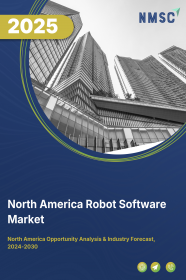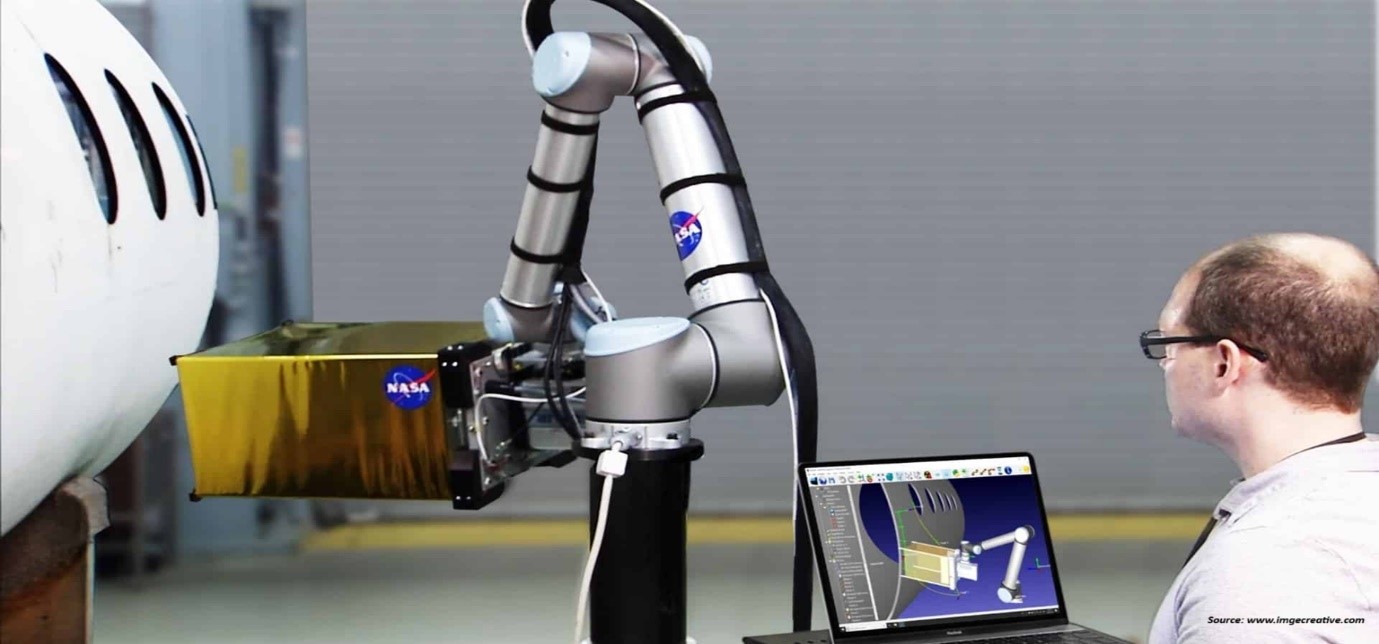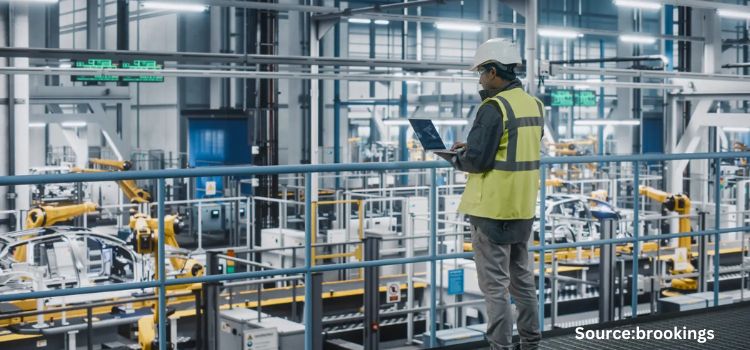
North America Robot Software Market by Software Type (Recognition Software, Simulation Software, Predictive Maintenance Software, Communication Management Software, and Data Management and Analysis Software), by Robot Type (Service Robots and Industrial Robots), by Deployment Mode (On-premise and On-demand), by Organization Size (Large Enterprises and Small and Medium-sized Enterprises (SMEs) – Opportunity Analysis and Industry Forecast, 2024–2030
Industry: ICT & Media | Publish Date: 14-Feb-2025 | No of Pages: 152 | No. of Tables: 108 | No. of Figures: 73 | Format: PDF | Report Code : IC2375
US Tariff Impact on North America Robot Software Market
Trump Tariffs Are Reshaping Global Business
North America Robot Software Market Overview:
The North America Robot Software Market size was valued at USD 4.69 billion in 2023, and is expected to reach USD 18.80 billion by 2030, with a CAGR of 20.9% from 2024 to 2030. Robot software encompasses a suite of programs and algorithms crafted to govern and supervise the activities of robots or robotic systems. These systems find utility across diverse industries such as logistics, manufacturing, entertainment, healthcare, and more. The functionality of robot software involves several vital components. Firstly, it manages and coordinates the movements and behaviors of robots, ensuring precise and efficient task execution by issuing detailed commands to robotic components such as motors and actuators.
Moreover, robot software plays a crucial role in interpreting data from various sensors embedded within robots. These sensors, spanning from cameras to Light Detection and Ranging (LIDAR) sensors and tactile sensors, provide indispensable environmental feedback, enabling robots to perceive and comprehend their surroundings. An essential aspect of robot software lies in its ability to make intelligent decisions using artificial intelligence (AI) and machine learning (ML) algorithms. By analyzing data from sensors, adhering to preset rules, or learning from past encounters, robots can adapt to evolving circumstances. This intelligence empowers them to operate autonomously, making instantaneous decisions and adjusting their behaviors accordingly.
Additionally, robot software facilitates intercommunication and networking among robots, fostering collaboration for intricate tasks or data exchange with a central control system. Within industrial environments, this interconnectedness enables synchronized operations, resulting in enhanced efficiency and productivity.
Growing Focus on Safety and Compliance Propels the North America Robot Software Market Trends
The increasing focus on safety and compliance serves as a significant catalyst driving the growth of the North America robot software market demand. With growing concerns surrounding workplace safety and regulatory adherence, organizations prioritize the adoption of robot software solutions that guarantee the safe and compliant operation of robotic systems. Robot software plays a pivotal role in implementing essential safety features, risk assessment tools, and compliance frameworks, thereby minimizing the risk of accidents and ensuring conformity with industry regulations and standards.
Moreover, as the regulatory landscape evolves and becomes more rigorous, there is a heightened demand for robot software capable of facilitating real-time monitoring, reporting, and documentation of safety and compliance metrics. By effectively addressing these concerns and offering robust solutions for safe and compliant operations, the increasing focus on safety and compliance fuels the adoption of robot software across various industries, thereby stimulating market growth.
Rising Labor Costs and Workforce Challenges Drive the North America Robot Software Market Growth
The rise in labor costs and ongoing workforce challenges are significant factors propelling the expansion of the North America robot software market. With labor expenses increasing, particularly within industries heavily dependent on labor-intensive tasks, organizations are actively seeking solutions to cut costs while maintaining productivity levels. This growing trend fosters widespread adoption of automation technologies, including robots, aimed at streamlining operations and reducing reliance on human labor. At the core of this shift lies the crucial role played by robot software, facilitating efficient programming, management, and optimization of robotic systems.
Additionally, workforce challenges such as skill shortages and demographic shifts provide further impetus for businesses to invest in robot software solutions, ensuring continuous operations and competitiveness. Consequently, the robot software market experiences sustained growth as organizations increasingly embrace automation to address labor-related hurdles and enhance operational efficiency.
Cybersecurity and Data Protection Concerns Associated with Robot Software Restrain the Growth of the North America Robot Software Market
Cybersecurity and data protection concerns associated with robot software remain substantial barriers to market growth. As robots increasingly integrate into digital ecosystems, they become susceptible to a range of cyber threats, from unauthorized access to data breaches and malware attacks. Inadequate cybersecurity measures within robot software can compromise sensitive data, intellectual property, and operational integrity, potentially resulting in financial losses and reputational damage for organizations.
Moreover, with the proliferation of IoT-enabled robots and the accumulation of vast amounts of data, there is an elevated risk of data privacy violations and regulatory non-compliance. Consequently, organizations are hesitant to adopt robot software solutions lacking robust cybersecurity features and data protection mechanisms, which hampers market expansion. Addressing these concerns through enhanced cybersecurity measures, encryption protocols, and compliance frameworks is crucial to fostering trust and encouraging broader adoption of robot software across diverse industries.
Development of Digital Twins and Simulation Software Creates New Opportunities in the North America Robot Software Market
The emergence of digital twins and simulation software creates fresh opportunities in the market by offering advanced tools for modeling, testing, and optimizing robotic systems in the region. Digital twins generate virtual replicas of physical robots and their surroundings, facilitating real-time monitoring, analysis, and predictive maintenance. Simulation software enables users to simulate different scenarios and environments, validating robot software algorithms and enhancing performance before deployment. These technologies provide notable advantages, including reduced development time and costs, improved scalability, and enhanced risk management.
Moreover, digital twins and simulation software facilitate collaborative development and training, enabling stakeholders to iterate and refine robot software solutions more efficiently. By furnishing robust tools for design, testing, and optimization, the emergence of digital twins and simulation software drives innovation and expedites the adoption of robot software across various industries.
The U.S. Dominates the North America Robot Software Market Share
The dominance of the U.S. in the North American robot software market can be attributed to several key factors. Firstly, the U.S. boasts a robust and innovative technology ecosystem, with leading companies investing heavily in research and development. This enables them to produce cutting-edge robot software solutions that cater to a wide range of industries, from manufacturing to healthcare. Additionally, the U.S. benefits from a large base of skilled engineers and software developers who contribute to the continuous advancement of robotics technology.
Furthermore, favorable government policies and initiatives support the growth of the robotics industry, encouraging investment and fostering a conducive environment for innovation. The presence of established industry players, coupled with a supportive ecosystem and a skilled workforce, solidifies the U.S.'s position as the dominant force in the North American robot software market.
Canada is Expected to Show a Steady Rise in North America Robot Software Market
Canada's steady rise in the North American market can be attributed to several factors. Firstly, Canada boasts a strong and diverse economy with key industries such as manufacturing, automotive, and healthcare increasingly adopting robotics technology to improve efficiency and productivity.
Additionally, Canada's commitment to innovation and research, evidenced by government support and investment in technology development, contributes to the growth of the robotics sector. Furthermore, Canada's strategic geographic location and strong trade relationships facilitate access to global markets, enhancing opportunities for Canadian robotics companies to expand their reach. As a result, Canada is poised to demonstrate continued growth and competitiveness in the North American robot software market in the coming years.
Competitive Landscape
Several key players operating in the North America robot software industry include IBM, NVIDIA, ABB Ltd., FANUC, Teradyne, Inc., H2O.ai, Brain Corp, CloudMinds, Clearpath Robotics, and Neurala, Inc. These market players are adopting strategies to maintain their dominance in the market.
North America Robot Software Market Key Segments
By Software Type
-
Recognition Software
-
Simulation Software
-
Predictive Maintenance Software
-
Communication Management Software
-
Data Management and Analysis Software
By Robot Type
-
Service Robots
-
Ground
-
Aerial
-
Underwater
-
-
Industrial Robots
-
Traditional Industrial Robots
-
Articulated Robots
-
SCARA Robots
-
Parallel Robots
-
Cartesian Robots
-
Other Robots
-
-
Collaborative Industrial Robots
-
By Deployment Mode
-
On-premise
-
On-demand
By Organization Size
-
Large Enterprises
-
Small and Medium-sized Enterprises (SMEs)
By Industry Vertical
-
Banking, Financial Services, and Insurance (BFSI)
-
Automotive
-
Retail and eCommerce
-
Aerospace & Defense
-
Healthcare and Life Sciences
-
Transportation and Logistics
-
Manufacturing
-
Telecommunications and IT
-
Academia and Research
-
Media & Entertainment
-
Others
By Country
-
The U.S.
-
Canada
-
Mexico
REPORT SCOPE AND SEGMENTATION:
|
Parameters |
Details |
|
Market Size in 2023 |
USD 4.69 Billion |
|
Revenue Forecast in 2030 |
USD 18.80 Billion |
|
Growth Rate |
CAGR of 20.9% from 2024 to 2030 |
|
Analysis Period |
2023–2030 |
|
Base Year Considered |
2023 |
|
Forecast Period |
2024–2030 |
|
Market Size Estimation |
Billion (USD) |
|
Growth Factors |
|
|
Countries Covered |
3 |
|
Companies Profiled |
10 |
|
Market Share |
Available for 10 companies |
|
Customization Scope |
Free customization (equivalent up to 80 working hours of analysts) after purchase. Addition or alteration to region, regional, and segment scope. |
|
Pricing and Purchase Options |
Avail customized purchase options to meet your exact research needs. |
KEY PLAYERS
-
IBM
-
NVIDIA
-
ABB Ltd.
-
FANUC
-
Teradyne, Inc.
-
H2O.ai
-
Brain Corp
-
CloudMinds
-
Clearpath Robotics
-
Neurala, Inc

















 Speak to Our Analyst
Speak to Our Analyst





















